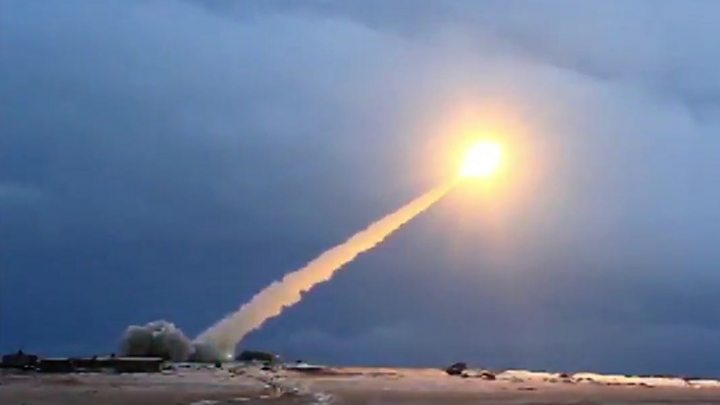replica this link
https://www.bbc.co.uk/news/world-europe-49319160 study greater about sharing. shut share panel Media playback is unsupported to your equipment Media captionPresident Putin says a new cruise missile can have 'limitless' latitude
Media playback is unsupported to your equipment Media captionPresident Putin says a new cruise missile can have 'limitless' latitudefive Russian nuclear engineers who died in a rocket engine explosion were buried in Sarov, a closed city 373km (232 miles) east of Moscow, the place nuclear warheads are made.
The Russian state nuclear company, Rosatom, spoke of the specialists had been trying out a nuclear-powered engine. however gave no additional technical particulars.
The verify turned into on an offshore platform within the Arctic, at a naval check latitude.
Russia has up to now demonstrated a nuclear-powered cruise missile, "Burevestnik".
however officials didn't specify the system involved in Thursday's disastrous examine.
The explosion turned into followed through a forty-minute radiation spike in Severodvinsk, a city 40km (25 miles) east of the Nyonoksa test range, by way of the White Sea.
Severodvinsk officials noted radiation in the city reached 2 microsieverts per hour, then fell again to the normal 0.eleven microsieverts. both levels are too small to cause radiation sickness.
Three other engineers had been injured within the blast, and at the moment are in hospital, Rosatom said.
experts in Russia and the West say the verify turned into obviously linked to the 9M730 Burevestnik, which means "petrel", a type of seabird. President Vladimir Putin described the missile in a speech to the Russian parliament in March 2018. Nato has given it the designation SSC-X-9 Skyfall.
Mark Galeotti, a leading Russia analyst and researcher on the Royal United capabilities Institute (Rusi), says nuclear propulsion poses large technical challenges. "there is speed versus the burden of the equipment, and the chance of a missile that spews radioactive exhaust anywhere it goes," he told the BBC.
"These new programs have their origin in Soviet instances - they've been taken off the cabinets and given new funding."
The Burevestnik's nuclear propulsion would, in keeping with Mr Putin, give it "unlimited" range. however the Nyonoksa explosion may have involved a different weapon, equally able to delivering a nuclear warhead:
The five nuclear engineers who died had been "elite" consultants and "heroes" who knew the dangers and had conducted outdated checks in "extraordinarily difficult conditions", senior Rosatom professional Valentin Kostyukov spoke of.
He heads the Sarov nuclear centre - a secret bloodless warfare-era facility answerable for Russia's hydrogen bomb arsenal.
He named the five as: Alexei Vyushin (a fashion designer and utility specialist); Yevgeny Korotayev (senior electrical engineer); Vyacheslav Lipshev (head of the scientific checking out group); Sergei Pichugin (trying out engineer); Vladislav Yanovsky (deputy head of the scientific testing branch).
at the funeral, Rosatom chief Alexei Likhachev stated "the most advantageous technique to be aware them is to continue our work on new types of weapon, which could be accomplished devoid of fail".
initially the defence ministry noted the explosion on 8 August had invol ved a liquid-gasoline rocket engine, and gave the loss of life toll as two, devoid of specifying the victims.
Later, Rosatom observed the verify had worried a "radio-isotope propellant supply" and had taken region on an offshore platform.
The engineers had completed trying out, but all at once a fireplace broke out and the engine exploded, throwing the men into the ocean, Rosatom spoke of.
quickly after the blast the Severodvinsk administration suggested a forty-minute spike in radiation in the city, and information of that brought about locals to purchase up shares of iodine within the city's pharmacies.
Iodine capsules offer some protection from radioactive iodine - and there turned into an important demand for them all through the 1986 Chernobyl disaster.
graphic copyright Reuters photo caption The Nyonoksa check range dates lower back to Soviet times - the hoarding stands close a naval barracksforward of the look at various, the defence ministry imposed an exclusion zone in Dvina Bay - the waters north of the Nyonoksa look at various latitude. The zone will continue to be closed to civilian transport until early September.
A Norwegian Arctic news web site, the Barents Observer, mentioned that a Russian specialised nuclear cargo ship, the Serebryanka, became inner the exclusion zone on 9 August.
There is theory that the ship become deployed to select up any radioactive debris in the experience of a failed verify, and can be doing just that now.
however the closed zone might also also be a precaution against any escape of poisonous rocket gas into the water, where locals go fishing.
Is the nuclear-powered missile a online game-changer?Rusi's Mark Galeotti says "there is lots of scepticism about even if the Burevestnik will ever see the light of day".
He notes that an extra state-of-the-art Russian missile, the Bulava, "had many y ears of failed tests".
The Zircon and Poseidon missiles are more superior projects. The Poseidon underwater drone already exists in prototype.
however Poseidon, like the Burevestnik, looks to be an "apocalyptic" weapon, Mr Galeotti says - impractical for the rest short of all-out nuclear conflict.
photograph copyright AFP image caption A museum in Sarov (1997 photo) has mock-u.s.a.of the primary Soviet A-bomb (foreground) and H-bomb (in the back of)Russia's govt newspaper Rossiiskaya Gazeta final month described Burevestnik as "a vengeance weapon". That became also the phrase used by means of the Nazis to describe their V-rockets, fired on the UK late in World war Two.
The newspaper referred to Burevestnik - able to long-length flight and fending off air defences - would goal any last a must-have infrastructure after Russia's intercontinental ballistic missiles had already struck enemy territory.
With the recent fall down of the Intermediate-latitude Nuclear Forces (INF) treaty, the united states will now center of attention extra on "setting up the intermediate-range arsenal, something short of all-out warfare", Mr Galeotti pointed out.
"The Russian militia additionally want that potential, because they are additionally concerned about China," he introduced.
No comments:
Post a Comment